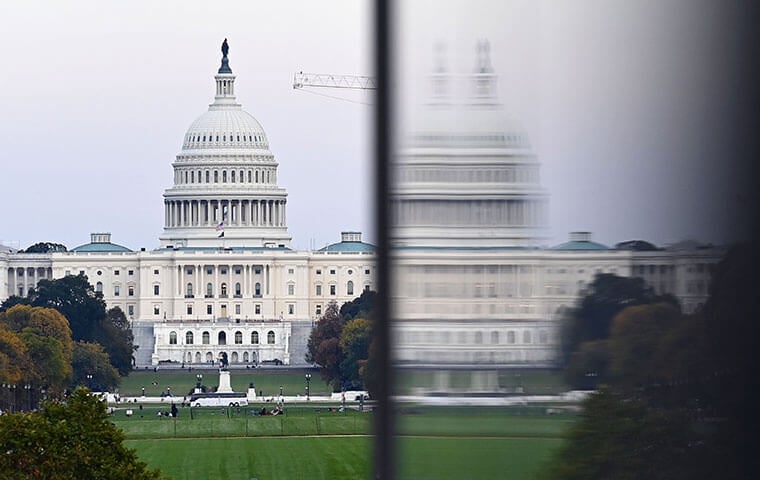 Until compromise remains politically more costly than the true costs of brinksmanship, this sort of legislating through continuing resolutions, shutdowns and brinksmanship will continue. Image: Xinhua/Shutterstock
By: FEDweek Staff
Until compromise remains politically more costly than the true costs of brinksmanship, this sort of legislating through continuing resolutions, shutdowns and brinksmanship will continue. Image: Xinhua/Shutterstock
By: FEDweek StaffThe Senate again failed to reach the 60-vote threshold to reopen the government Monday—its 11th failed vote since the shutdown began on Oct. 1—underscoring how the threat of funding lapses have morphed into routine, high-stakes bargaining tools.
The price of stalemate. Each lapse leaves a “shutdown premium” even after back pay—$3–4 billion in unrecoverable costs tied to lost productivity and emergency reprogramming. Grants, contracts, and agency operations stall; hundreds of thousands of federal workers miss paychecks. The cumulative hit rivals major program budgets, and the disruptions ripple across states, universities, and vendors through delayed or canceled awards.
Where the deal keeps breaking. Two main pressure points define the impasse:
- ACA premium subsidies: Democrats want an extension embedded in the deal; Republicans, led by Majority Leader John Thune, have rejected that approach and offered only a separate vote.
- Reprogramming of funds and rescissions.
A shadow appropriations track. The 2025 shutdown—the longest lapse since 2019—has evolved from a pause in funding into parallel budgeting by policy rider and reprogramming. Lawmakers attach concessions; agencies then move money within legal guardrails to sustain selected operations, effectively shifting priorities outside the normal cycle. The result: winners and losers determined mid-shutdown rather than in regular appropriations.
Selective protection, uneven pain. Unlike most federal employees, active-duty service members received Oct. 15 pay after the Pentagon tapped roughly $6.5 billion in unobligated research and development funds to cover salaries during the first half of the lapse. The White House has extended payroll protection to selected law-enforcement personnel; DHS Secretary Kristi Noem announced a “super check” on Oct. 22 for more than 70,000 officers (including Border Patrol, ICE, and Secret Service) covering missed days and overtime. FBI Director Kash Patel said bureau agents will continue to be paid. As President Trump put it: “We got the people that we want paid—paid.”
By contrast, sectors without special protection face sharper impacts. Defense manufacturers and large IT vendors often secure stopgaps or are deemed “essential,” preserving cash flows. Small businesses reliant on federal contracts or community grants can face layoffs or bankruptcy when payments halt, and contractors have no guaranteed back pay.
Facts at a glance
- 22 total funding gaps or shutdowns since Congress adopted the modern process in 1976
- 5 shutdowns since 9/11 (2001; 2013; Jan 2018; Dec 2018–Jan 2019; Oct 2025)
- 35 days: longest in U.S. history (Dec 2018–Jan 2019)
- $11 billion: estimated permanent GDP loss from the 2018–2019 shutdown (CBO)
- ~600,000 federal employees furloughed and 500,000 working with pay (about 400k at VA and another 100k+ DoD)
- ~1 million federal employees excepted and working without pay in the current lapse
- $3–4 billion: average unrecoverable cost per shutdown (CBO/OMB)
- 0 contractors guaranteed back pay
- 22 days: duration of the current shutdown as of Oct. 22, 2025
Earlier contingency plans projected about 700,000 excepted employees; updated tallies now put it closer to 2 million as agencies revised operations.
Public tolerance tends to hinge on visible disruptions—flight delays, closed parks, suspended grant flows. As those effects spread, pressure on negotiators often accelerates. Meanwhile, the current approach—sequencing high-stakes riders and relying on reprogramming—blurs accountability: the political costs of brinkmanship and governing by continuing resolution are easier to redirect across the aisle than the concrete costs borne by workers, grantees, and taxpayers.
Another failed vote reinforces the new normal: the threat of shutdowns as leverage, policy concessions as currency, and behind-the-scenes budget shifts that redistribute who gets paid—and who waits—until a deal is struck.
Senate Eyes Vote to Pay Federal Employees Working Unpaid
Series of Bills Offered to Address Shutdown’s Impact on Employees
Public Starting to Feel Impact of Shutdown, Survey Shows
OPM Details Coverage Changes, Plan Dropouts for FEHB/PSHB in 2026
Does My FEHB/PSHB Plan Stack Up? Here’s How to Tell
2025 TSP Rollercoaster and the G Fund Merry-go-Round
See also,
TSP Takes Step toward Upcoming In-Plan Roth Conversions
5 Steps to Protect Your Federal Job During the Shutdown
Over 30K TSP Accounts Have Crossed the Million Mark in 2025

